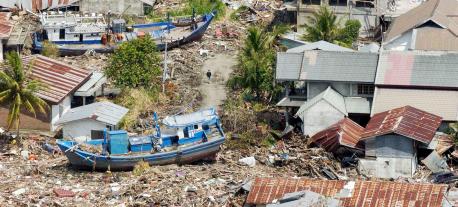
2004 Indian Ocean Earthquake and Tsunami
UNICEF teams were mobilized in eight countries — Indonesia, Thailand, Myanmar, Malaysia, Sri Lanka, the Maldives, India and Somalia — to deliver emergency relief to impacted children and families.
A devastating tsunami
On Dec. 26, 2004, a 9.1-magnitude earthquake unleashed massive tidal waves across South Asia. Powerful tsunamis slammed into the coasts of India, Indonesia, Sri Lanka, Thailand, the Maldives, Malaysia, Myanmar, the Seychelles and Somalia, devastating thousands of miles of coastline, and the communities that depended on them.
The tsunami wiped away homes, schools and health facilities; it demolished roads, bridges and power lines; it irrevocably altered the lives of millions of people. Tragically, more than one-third of the estimated 230,000 tsunami deaths and missing persons were children.
UNICEF’s relief efforts after the 2004 tsunami
UNICEF was on the ground in the affected region at the time of the tsunami disaster and went to work immediately to provide lifesaving humanitarian relief to the survivors.
Teams were mobilized in eight countries — Indonesia, Thailand, Myanmar, Malaysia, Sri Lanka, the Maldives, India and Somalia. Top priorities included providing clean drinking water and preventing malnutrition, measles and other disease outbreaks.
With child trafficking concerns heightened, UNICEF moved quickly to provide safe havens for lost children and help them reunite with relatives. UNICEF also focused on getting children back to school as quickly as possible, recruiting teachers, creating makeshift classrooms and providing supplies.
In Aceh, Indonesia's northernmost province and the hardest hit, 21 Child-Friendly Spaces were set up where children could regain a sense of normalcy and recover from trauma through education, play and psychosocial support. It was in post-tsunami Indonesia that UNICEF first piloted its Art-in-a-Box, which provides children affected by disaster with materials to express themselves through the arts and work through their emotions.
Send an Art-in-a-Box directly to children in emergency settings via UNICEF Inspired Gifts.
Recovery efforts after the 2004 South Asia tsunami
In the years since the South Asia tsunami, UNICEF-supported programs helped transform the tsunami-affected communities in building back better.
In Aceh, for example, about 350 new earthquake-resistant and better-equipped schools were built with UNICEF's assistance. UNICEF also helped strengthen Aceh's community-based health care and reform the juvenile justice system.
In Thailand and Sri Lanka, water and sanitation systems were upgraded, and more rigorous child protection measures were put in place. UNICEF-led tsunami reconstruction efforts have greatly improved basic services like health, education and sanitation, but also enhanced security and disaster-preparedness in these regions that are so vulnerable to natural disasters.
Learn more about how UNICEF responds to earthquakes and tsunamis globally.
